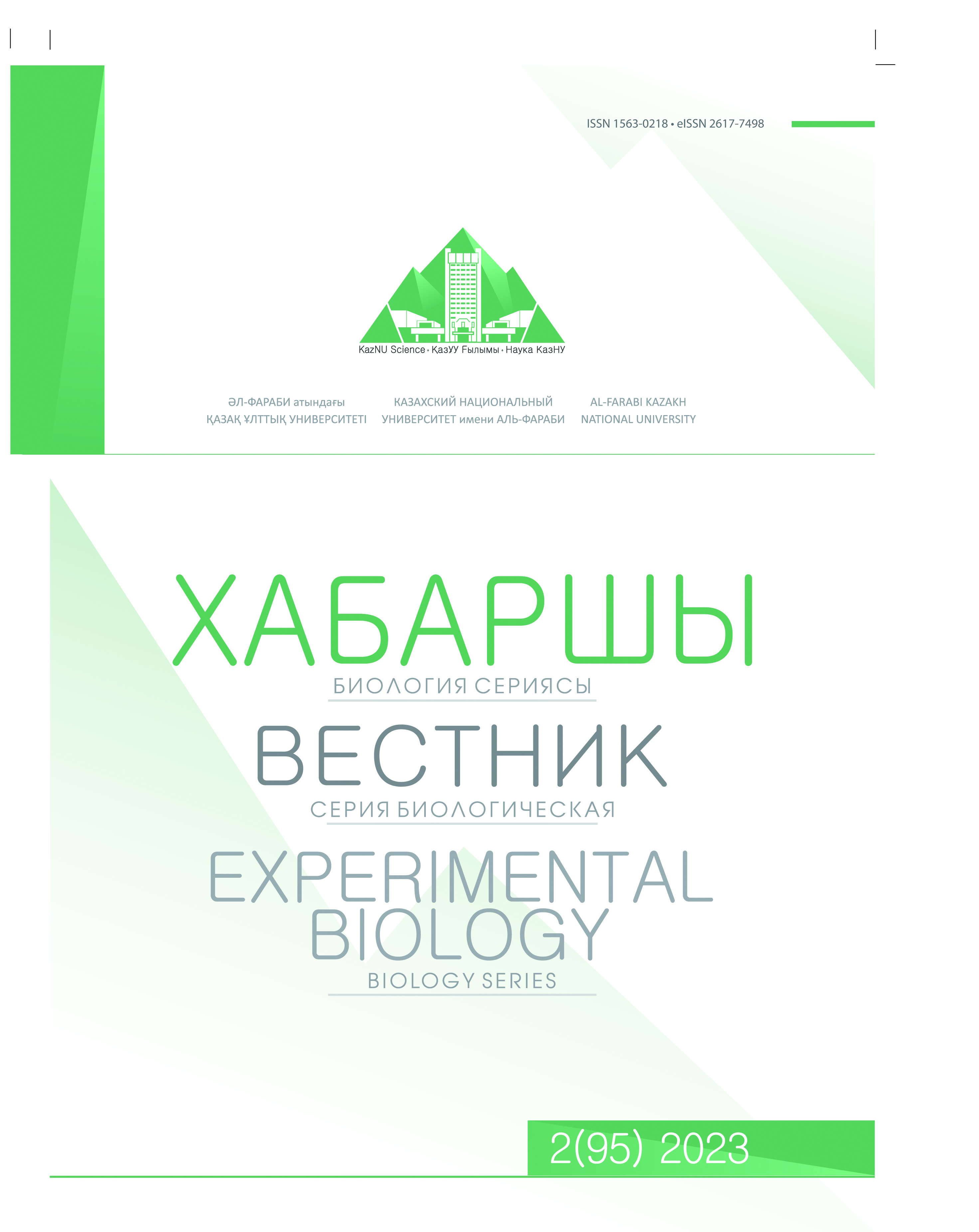ГИСТОЛОГИЧЕСКИЕ ПОКАЗАТЕЛИ ЯГНЯТ СЕРОЙ ОКРАСКИ РАЗНОЙ РАСЦВЕТКИ ЖАКЕТНОГО СМУШКОВОГО ТИПА
DOI:
https://doi.org/10.26577/eb.2023.v95.i2.013Ключевые слова:
каракуль, расцветка, эпидермис, пилярный слой, ретикулярный слой.Аннотация
В настоящее время в условиях рыночной экономики существует ряд проблем, препятствующих повышению качества каракуля. Одним из них является необходимость совершенствования эффективных методов селекции и разведения с учетом особенностей каракульских овец, углубленного изучения гистоморфологических структур кожи и шерсти ягнят разных расцветок и повышения продуктивности каракульских овец.
Целью настоящего исследования является изучение гистоморфологических особенностей ягнят разных расцветок жакетного смушкового типа, полученных от серых каракульских овец.
По результатам исследования у тёмно-серых ягнят жакетного типа перламутровой расцветки толщина ретикулярного слоя кожи составила 532,2 мкм у темно-серых - 537,7 мкм, или на 43,4% (8,78%) и 46,5 мкм (9,47%) толще, чем у ягнят светло-серой окраски молочной расцветки и средне- серой окраски голубой расцветки жакетного смушкового типа (P <0,05).
Видно, что у ягнят средне-серой окраски свинцовой расцветки диаметр вторичных волосяных фолликулов на 1,48% и 7,44% толще, чем у ягнят темно-серой окраски стальной и голубой расцветок соответственно. Коэффициент отклонения диаметра волосяных вторичных фолликул шерсти колебался в пределах Cv = 15,6-20,5.
По количеству вторичных волосяных фолликул видно, что у ягнят светло-серой окраски стальной расцветки жакетного смушкового типа на 6,04% и 9,79% больше, чем у ягнят светло-серой окраски голубой и перламутровой расцветок (Р<0,05). По соотношению числа потовых и сальных желез (СЖ/ПЖ) установлено, что у светло-серых ягнят составляет в пределах 1,90-1,95 штук, у средне-серых ягнят 1,95-2,03 и у темно-серых ягнят 1,89-1,91.
Библиографические ссылки
Aktas A., Daglioglu S., et al. Examination of structural features of skin in sheep breeds fetuses with histological methods // Kafkas Unis Vet Derg. 2009; 15; - P. 391-6.
Banks W.J. Applied Veterinary Histology. William and Wilkins, Baltimore London. (1993); - P. 341– 371.
Bragulla H.H., Hombergwer D.G. Structure and Functions of Keratin Proteins in Simple Stratified Keratinized and Cornified epithelium // J. Anat. 214: (2009); - P. 516–550
Bovell D.L, Corbett A.D., Holme S., Macdonalld A., Harker M. The absence of apocrine glands in the human axilla has disease pathogenetic implications including axillare hyperhidrosis // Bri. J. dermatol. 150 (6): (2007); - P. 1278–1286 .
Carter H.B. Groups of hair follicles in sheep //New in sheep breeding. – M., -1957. –P. 48-51.
Colville T., Bassert J.M. Clinical Anatomy and physiology for veterinary Technicians. 2nd ed. (2008); - P. 131–138.
Diomidova N.A. Features of the structure and development of the skin in gray karakul lambs //Tr. IMZn AN USSR, issue 7, -1952. – P. 114-119.
Diomidova N.A. Individual features of the structure and development of the skin and hair follicles in karakul lambs // Karakul breeding and fur farming. – 1957. - №1. – P. 24-26.
Diomidova N.A., Panfilova V.P., Suslina E.S. Methodology for the hair follicles in sheep. –M., - 1960. – 39 p.
Edmonds R Coopes S The importance of elastin distribution and morphology in ovine leather // J Aqeic. 2012. https://orion.euetii.upc.es/3web/catA3/journal/repo/2012/V63N3/ eng/01.pdf.
Erezhepov S. Age-related changes in the thickness of the skin and hair follicles in Karakul sheep of various astrakhan types //Sheep, goats, woolen business.– 2015. № 4. – P. 48-49.
Erezhepov S. Conjugation of the histostructure of the skin with economically useful traits of Karakul lambs //Sheep, goats, woolen business.– 2016. № 4. – P. 30-31.
Erezhepov S. Histostructure of the skin of karakul lambs of flat astrakhan type, obtained form various options of selecting karakul seep according to the astrakhan type //Sheep, goats, woolen business.– 2015. № 4. – P. 51-51.
Genkovski D., Gerchev G. Study of the skin Histological structure in ewes from Staroplaninska and Thoroughbred. Biotechnology in animal husbandry Belgrade – Zemun. 23 (5–6). (2007); - P. 191–197.
Gbolagunte G.D., Hambolu J.O., Akpavie S.O. Pathology and leather surface
Appearance of disease aficted Nigerian small ruminant skins //AU JT. 2009; 4: - P. 271-83.
James G.M., Jeffery M. Lookinbill and Marks' principles of dermatology 4thed. (2006); - P. 6.
Junqurira L.C., Carneiro J., Basic Histology. The McGraw– Hill companies, USA, (2005); - P. 370-380.
Kaladinov O. Histomorphological features of the skin of karakul lambs of different astrakhan types // Research, results. – 2007. № 3. – P. 86-88.
Kydyrbaeva A.E.,Nurkalykova B. Histological structure of the skins of karakul lambs of different types of fur // - Almaty. –Bulletin. – 2001. № 9. – P. 7-8.
Kydyrbaeva A.E., Esentureeva G.E. The glandular apparatus of the skin of karakul lambs //Scientific Review. Biological Sciences. – 2017. № 1. –P. 107-112.
Krause W.J., Cutts J.H. Concise text of Histology 2nd ed. (1986); - P. 273-282.
Lakhanova K.M. Age-related changes in the histostructure of the skin of Karakul ewes //Vestnik nauki Kazakh. GAU im. S.Seifullin. – 2009. № 1. –P. 102-105.
Mobini B Histological feature of the skin at diferent regions and in diferent ages of Lori-Bakhiari sheep // Leban Sci J/J Sci Liban. 2015; 16: - P. 89.
Montagna W. The structure and function of skin // 2nd ed. Academic Press. New York USA. (1962); - P. 351-369.
Munger B.L, Brusilow S.W. The histophysiology of rat planter sweat gland Anat. Res. 19: (1971); - P. 6-7.
Narbota B.E., Saniyazova A.Zh. Morphometry of hair follicles of karakul lambs //Modern aspects of the development of agriculture in the southwestern region of Kazakhstan. – 2018. – P. 118-122.
Oznurlu Y., Celik I., Sur E., Telatar T., Ozparlak H. Comparative Skin Histology of the White New Zealand and Angora Rabbits // J Anim Vet Adv. 2009; 8: - P. 1694-1701.
Ombaev A., Ilyasov A. Technology of complete processing of animal skins // -Almaty, LLP Publishing house Bastau . -2007. – 168 p.
Richard W., Hunter J., Savin J., Dahl M. Clinical dermatology (4thed) malden massachuesttes USA // Black net publishing. (2008); - P. 268
William J., Timothy B., Dirk E.. Andrews' Disease of the skin: clinical Dermatology (10th ed). Saunders. (2005); - P. 2.




